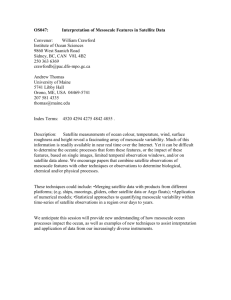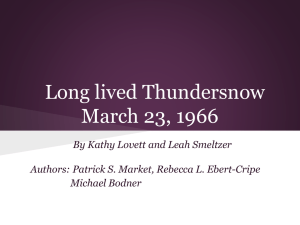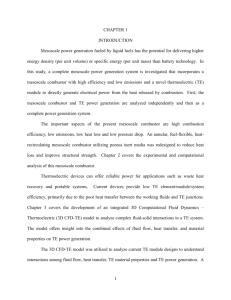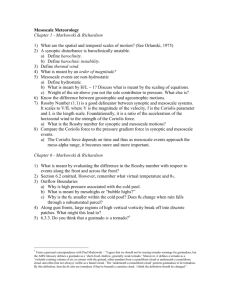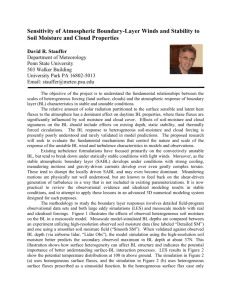Activities of the Mesoscale Working Group: October 2009
advertisement
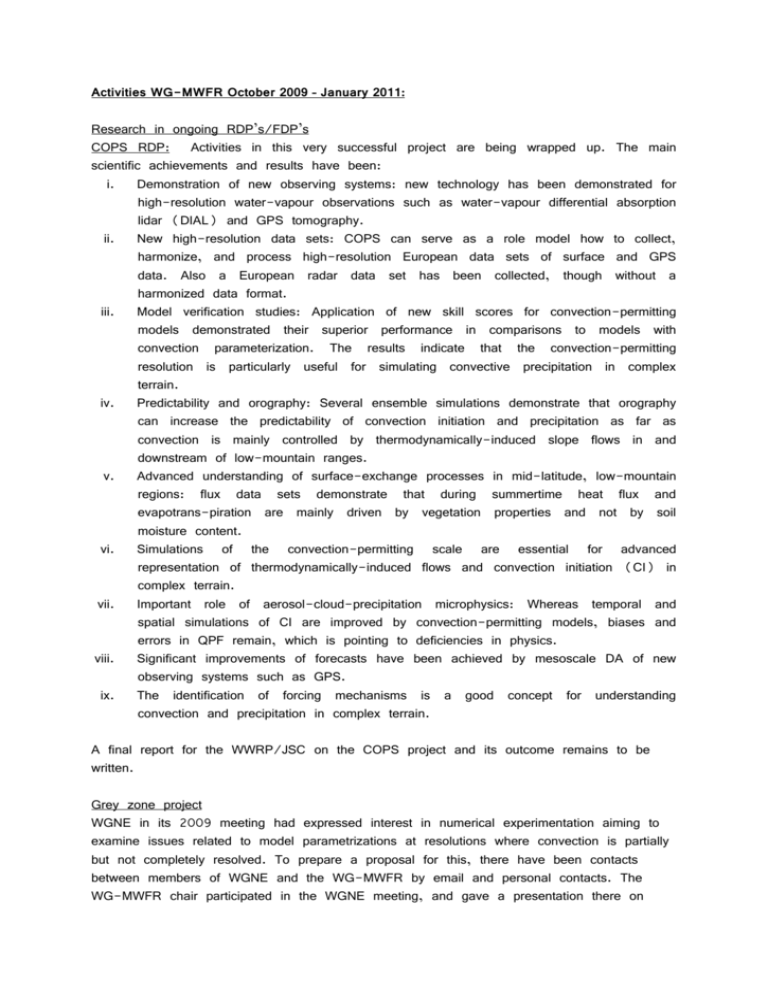
Activities WG-MWFR October 2009 – January 2011: Research in ongoing RDP’s/FDP’s COPS RDP: Activities in this very successful project are being wrapped up. The main scientific achievements and results have been: i. Demonstration of new observing systems: new technology has been demonstrated for high-resolution water-vapour observations such as water-vapour differential absorption lidar (DIAL) and GPS tomography. ii. New high-resolution data sets: COPS can serve as a role model how to collect, harmonize, and process high-resolution European data sets of surface and GPS data. Also a European radar data set has been collected, though without a harmonized data format. iii. Model verification studies: Application of new skill scores for convection-permitting models demonstrated their superior performance in comparisons to models with convection parameterization. The results indicate that the convection-permitting resolution is particularly useful for simulating convective precipitation in complex terrain. iv. Predictability and orography: Several ensemble simulations demonstrate that orography can increase the predictability of convection initiation and precipitation as far as convection is mainly controlled by thermodynamically-induced slope flows in and downstream of low-mountain ranges. v. Advanced understanding of surface-exchange processes in mid-latitude, low-mountain regions: flux data sets demonstrate that during summertime heat flux and evapotrans-piration are mainly driven by vegetation properties and not by soil moisture content. vi. Simulations of the convection-permitting scale are essential for advanced representation of thermodynamically-induced flows and convection initiation (CI) in complex terrain. vii. Important role of aerosol-cloud-precipitation microphysics: Whereas temporal and spatial simulations of CI are improved by convection-permitting models, biases and errors in QPF remain, which is pointing to deficiencies in physics. viii. Significant improvements of forecasts have been achieved by mesoscale DA of new observing systems such as GPS. ix. The identification of forcing mechanisms is a good concept for understanding convection and precipitation in complex terrain. A final report for the WWRP/JSC on the COPS project and its outcome remains to be written. Grey zone project WGNE in its 2009 meeting had expressed interest in numerical experimentation aiming to examine issues related to model parametrizations at resolutions where convection is partially but not completely resolved. To prepare a proposal for this, there have been contacts between members of WGNE and the WG-MWFR by email and personal contacts. The WG-MWFR chair participated in the WGNE meeting, and gave a presentation there on what is presently known about convective behaviour in the grey zone, the challenges at grey-zone resolutions and possible experiments by which more insight can be gained. Although present mesoscale models are usually well able to represent strongly forced convection, the initial stages of deep convection where it is not yet well organized are difficult to describe. Model behaviour is very sensitive to the interplay between convection, microphysics and turbulence, and it appears that a more inherently 3D and stochastic description of parametrized processes is necessary to describe these early stages of deep convection realistically. Most experimentation with mesoscale models has been carried out in the extratropics; it appears, however, that grey zone problems may start to occur at coarser resolutions in the tropics. This problem needs more attention from the mesoscale modelling community. WGNE enthusiastically supported the proposal to take forward coordinated work in this area, and discussed options for practical next steps. Not only mesoscale modelling groups but also global NWP and climate modellers have expressed interest in participating. A planning group involving members of WGNE, WG-MWFR and GCSS was formed with the task to set up a framework for idealized grey-zone studies for the coming years. It is aimed to start with a study on a case in the early stages of deep convection, over sea. With this study, the modellers involved can set up and test a practical experimentation framework, which later can be extended to other relevant grey zone case studies, such as tropical deep convection. The idea is to use a set of LES models at very high resolution to establish the “truth”, and then progressively degrade horizontal resolution down to~10km. The planning group has established a number of cases which may serve as the initial case study, and has been in touch with the LES and mesoscale NWP modelling communities. A number of groups have expressed their willingness to participate. The proposed experimental setup can be handled by some of them, but several models may require adaptations to perform the proposed experiments. The needs and possibilities for this are being investigated at the moment. Towards routine mesoscale model verification Verification and intercomparison of NWP models according to internationally agreed standards is being done routinely for global models, but not yet for the mesoscale. Generally accepted quality standards suitable for assessing mesoscale LAM models do not yet exist. The limited model domains of mesoscale models are a serious hindrance for model intercomparisons. Despite these difficulties, the WG-MWFR feels it to be essential to push for routine verification and quality assessment of mesoscale models. It aims for (1) the development and promotion of commonly accepted standards (methods and metrics) for mesoscale verification in close cooperation with the WG on Verification, and (2) routine monitoring and international exchange of such data. The WG on Verification has been contacted with the request to assist in the formulation of a basic set of quality metrics and methods that can be promoted for use world-wide. Members of both groups have met and discussed this issue on several occasions. Parameters to be verified should in any case include near-surface wind and precipitation. To capture the various quality aspects of precipitation, presumably a set of several verification scores will be required. The verification techniques will most likely include spatial and probabilistic methods. Preferably also cloud information should be verified in some way. The WG on Verification has been urgently requested to develop suitable recommendations for this. Secondly, the WG aims to push for routine monitoring and where possible international exchange of mesoscale verification data. For several operational mesoscale models with overlapping domains, model intercomparisons have proven possible and useful, and the WG would like to promote such intercomparisons to be carried out structurally. Within Europe, a EUMETNET programme on verification has been established by which several regional models are routinely verified using conventional verification techniques and scores. Members of both the WG on verification and the WG-MWFR are involved in this programme. It is aimed to extend this programme in the coming years to include more detailed mesoscale models, and more appropriate verification measures from spatial techniques. In this way, the Verification programme could be a test bed for international mesoscale model intercomparison. Training and training material The WG has recently begun work on one of its aims, to identify possible gaps in training on mesoscale NWP (initially focussing on duty forecasters), and organize the provision of training material and expertise where needed. A start is being made with an inventory of available mesoscale NWP training material, and with making contacts with relevant experts on this, such as the people involved in the EUMETNET training programme EUMETCAL. Preparations for new actions - Sochi 2014: A combined RDP/FDP is in preparation for the meteorological support of the Sochi 2014 Winter Olympics. The working group has been involved in partner search and providing advice to Roshydromet on a number of issues. The WG on Nowcasting Research has engaged itself in this project as well. The kickoff meeting, in which the scope of the project will be defined, will be held on March 1-3 2011 in Sochi, with participation of one WG-MWFR member. - Tokyo Metropolitan Field campaign: In the coming years, JMA together with several other organizations will carry out the Tokyo Metropolitan Convection Campaign. During this campaign, a very dense network of observations (a comprehensive set of X-, Ku, and polarimetric C-band radars, lidars, additional surface rain gauges, radio sondes and GPS observations) will be deployed over the Tokyo Metropolitan Area to study the characteristics of convection and convective precipitation over this urban area. The resulting data will be used for high-resolution model validation and verification, assimilation, and for the assessment of and use in a convection-permitting ensemble (hourly, 1-2 km, 40-100 members). Working group members have gauged the interest of JMA and its partners to seek international research cooperation in this project as a prospective RDP. There was no clear interest in this. Given the potential importance of this dense dataset for research on urban modelling, mesoscale assimilation and ensemble forecasting, however, the working group members continue to explore the possibilities of archiving the campaign data and making them available for future research use by others. - Two other mesoscale research proposals, EUROPredict and EUREPS, have been prepared by working group members and submitted to the European Science Foundation and EUMETNET, respectively. Both applications have been unsuccessful. Organization of symposia/workshops - Participation of WG-MWFR member in the Scientific Organizing Committee of the WMO QPE/QPF Symposium, October 2010 in Nanjing. In preparation: - A workshop on the use of mesoscale NWP in nowcasting (invitation only), organized as a joint activity with the WG on Nowcasting research. The aims of this workshop are: to assess the present state-of-the-art in this field, to promote direct contacts between the nowcasting and mesoscale modelling communities, and to initiate research / demonstration activities targeted at assessing and enhancing the potential of mesoscale NWP systems for nowcasting purposes. An outcome of this workshop may be the formulation of an RDP or FDP proposal to JSC. The programme setup and list of participants have been set up; invitations will be sent out as soon as permission from the JSC is given. Expected date and location of workshop: 25-27 June 2010 at NCAR, Boulder. - Workshop on surface characterization for mesoscale models. Aim: within the NWP community, expertise on physiographic data and the derivation of model surface climate fields is limited, and physiographic datasets are often used without a true understanding of their limitations. The workshop is intended to have experts in this field document and explain the state-of-the-art in physiographic data handling, and to establish recommendations on best practices. It is hoped that, as a follow-up, a more permanent expert team may be formed with the aim to formulate and promote guidelines for handling physiographic data. Working group members are presently engaged in making the required contacts and studying the main challenges in this field. Expected time: early 2012. Location: not yet known. Contacts with other WWRP working groups: WG-Nowcasting research: Joint preparation of the workshop “Use of NWP in nowcasting”, June 2011, Boulder. Incidental contacts concerning the preparation of the Sochi 2014 RDP/FDP. In the next meetings of both WG’s, it will be attempted to have at least one member of the other group participate, in person or through videoconferencing/skype-type facilities. WG-Verification: Contacts by email on the needs and possibilities for routine mesoscale verification and model intercomparison. Participation of a WG-verification member in the August 2010 WG-MWFR meeting, and contacts of the chairs of the WG’s at the WGNE meeting It is intended to arrange a joint meeting of the two WG’s in September 2011 in Berlin. WGNE: Participation of the WG-MWFR chair in the WGNE meeting of October 2010, in which she presented the status of mesoscale modelling experiences in the grey zone and discussed possible experimentation in the grey zone. Work on this has started (see above). At this meeting, it was further agreed to invite the WG-MWFR chair as ex-officio member to future WGNE meetings. Formal arrangements for this have been made.
